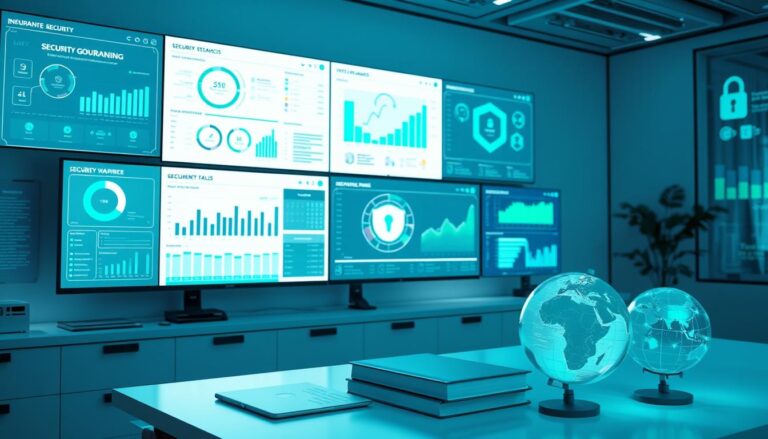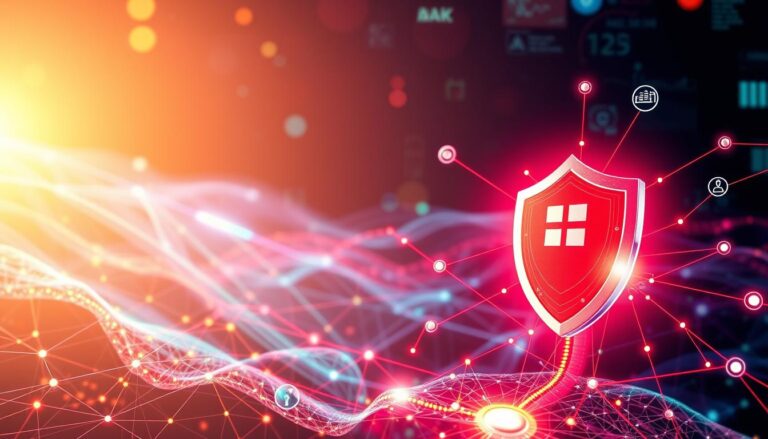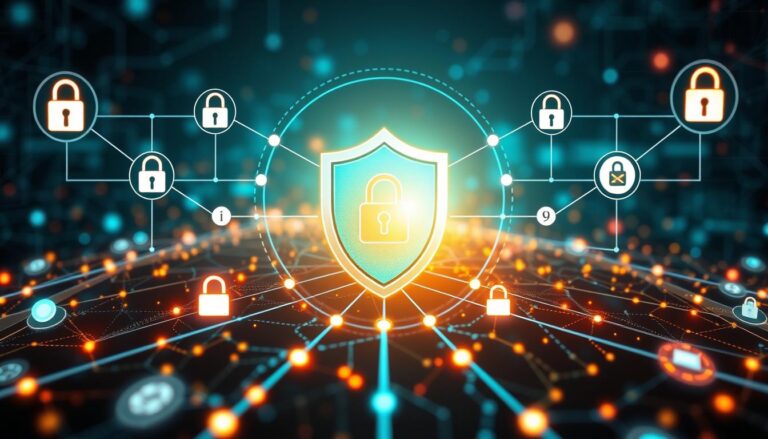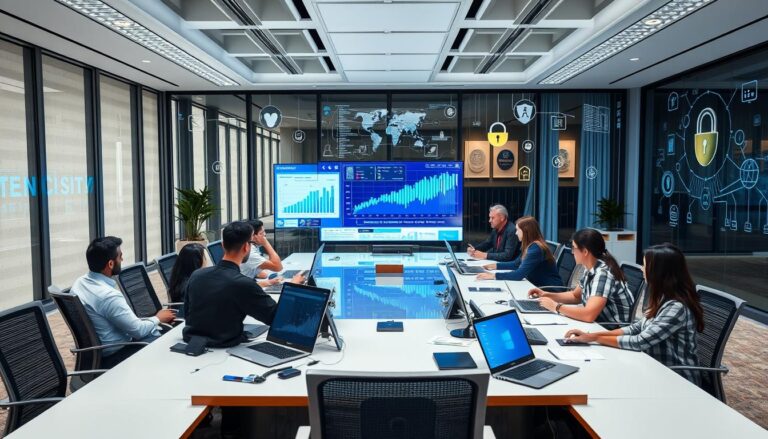
Did you know that data breaches can cost a lot? On average, they cost $3.86 million per breach worldwide in 2023. This shows how important it is for companies to have clear roles and responsibilities in their information security plans. In fact, 62% of organizations don’t really get what their information security roles are, which makes them more vulnerable.
Creating a solid governance framework helps align with business goals and reduces cyber threats. By giving specific roles in information security, everyone knows their part in the security plan. As companies take on strong cyber security governance responsibilities, they become more resilient against breaches. They also make following rules like GDPR and HIPAA easier.
The Importance of Information Security Governance
Information security governance is key in today’s digital world. A study found that 75% of companies lost money due to cyber attacks because of poor governance. It’s vital for businesses to have strong governance to protect their digital assets and avoid risks.
Companies with advanced governance practices saw fewer data breaches. In fact, 80% of breaches happened in companies without a clear governance plan. This shows the need for good organizational control to keep data safe.
Using a risk-based approach to governance can cut security incidents by 30%. This method is supported by 70% of executives who see governance as key to avoiding reputational damage. Good governance not only boosts data security but also helps with compliance, saving up to 70% on fines.
Leadership involvement in security discussions is critical for success. About 90% of security experts say leaders must be involved for effective risk management. When boards get involved in cybersecurity, the risk of big incidents drops by 50%.
Companies that use frameworks like NIST and ISO 27001 can cut compliance costs and better manage risks. These frameworks help in making better decisions, with governance committees improving decision-making by 50% in studies.
In short, strong information security governance leads to more customer trust, lower costs, and better defense against cyber threats. The data clearly shows that a focused approach to governance is vital for staying competitive and keeping the organization safe.
Understanding Information Security Governance Roles
It’s key to know the roles in information security governance for good security. Many important people work together to help an organization deal with security issues. Having clear roles helps everyone know what to do and who is in charge.
Key Stakeholders in Information Security Governance
Key stakeholders in information security governance include:
- Executives: They set the direction for security efforts.
- Chief Information Security Officer (CISO): They manage the security plans.
- IT Security Staff: They handle the daily security tasks.
- Board of Directors: They watch over everything and make sure it fits with the business goals.
These people work together to keep risks low. They make a team effort to protect information.
Impact of Clear Role Assignments
Having clear roles makes a big difference. Studies show that:
- Security incidents can drop by up to 30% with better teamwork.
- 70% of companies follow laws better with a clear plan.
- 80% of companies feel more confident in protecting data with a good plan.
81% of companies have roles for managing information security. Making sure these roles match business goals is important. It helps everyone support security efforts better.
A Role Beyond Administration: Business Leaders in InfoSec Governance
Business leaders in infosec governance do more than just manage. They help set the direction and decide how much to spend on security. They also help others understand how security affects the business.
As technology gets more complex, the need for executives to handle security has grown. A study by Girn (2022) shows that senior management needs to be more involved. Companies now see that security policies should start at the top to cover everything.
It’s important for infosec to be part of the company culture. Leaders can make this happen by speaking the security language. They need to make sure everyone in the company understands and follows these values.
Companies that focus on security at the top level do better. They are more open and have fewer security problems. Studies show that working with outside auditors makes financial reports more reliable, showing how security and governance are connected.
Having a strong security plan is key to protecting data and meeting company goals. A good governance model makes the company stronger. It helps teams deal with new security challenges.
| Level of Governance | Description | Percentage in Organizations |
|---|---|---|
| Ad Hoc Governance (Level 1) | Minimal engagement, common in startups | 30% |
| Establishing Basic Structures (Level 2) | Improved structures due to regulatory pressure | 45% |
| Going Beyond the Basics (Level 3) | Broader engagement beyond core functions | 15% |
| Extending and Maturing (Level 4) | Security integrated in operations and planning | 8% |
| Embedded Governance (Level 5) | Full integration with business strategies | Less than 2% |
Business leaders in infosec governance have a big role to play. They lead the charge in keeping information safe. Their efforts help protect the company from threats and build a culture of responsibility.
The Role of Executive Team Members
Members of the executive team in information security are key in setting up a cybersecurity strategy. They link company goals with effective risk management. This helps them use resources well, making sure responses match the real risks.
Good resource use boosts cybersecurity efforts and helps avoid OT threats. Many miss the big risks in OT cybersecurity breaches. These can harm safety, finances, and the environment. It’s important to understand these risks when deciding on cybersecurity spending.
Executive team members should regularly check risks and use a risk scale like a risk matrix. This helps them make smart choices on where to spend on cybersecurity. Tools like cyber PHA and HAZOP help them deeply analyze cyber risks.
They also play a big part in planning OT cybersecurity for years ahead. Focusing on the most important plants helps use resources better. This improves the organization’s security. Working with the board of directors shows a strong commitment to managing risks well.
How Boards Play Pivotal Roles
The role of the board of directors has changed a lot in today’s digital world. They now make sure cybersecurity is part of the company’s big plans. This change means boards have to take a big role in fighting off today’s cyber threats.
Board Accountability in Cybersecurity
Boards need to know about the dangers of industrial systems in the digital age. These systems are now at risk from new kinds of attacks. This is why boards have to get involved.
- Boards need to be proactive in cyber governance to stay safe.
- They should focus on training people in security.
- Keeping third-party supply chains safe is also important.
- Using AI in cybersecurity can help find and stop threats better.
Studies show boards play a big role in keeping cybersecurity strong. For example, 70% of companies with board help do better in following rules. Also, 90% think board help is key to keeping trust. And, companies that focus on following rules see fewer data breaches.
| Actions Taken by the Board | Impact on Cybersecurity |
|---|---|
| Regular briefings on cyber risks | Enhanced awareness of threat landscape |
| Participation in audit processes | Improved implementation of security controls |
| Mandating ongoing SOC 2 training | Increased adherence to security protocols |
| Quarterly reviews of SOC 2 compliance | Proactive risk management |
| Integration of cybersecurity in organizational strategy | Higher ROI on security investments |
Cybercriminals keep getting better at what they do. Boards need to keep up. Good cybersecurity governance is more important than ever. This is because of new SEC rules that might make companies talk about their cybersecurity more.
Formulating an Effective Information Security Governance Framework
Creating a good information security governance framework is key. It helps your organization’s business and tech strategies match up. It also makes sure you follow the rules.
Your framework should be clear. It should show who does what and how to avoid risks.
There are six main things to focus on to improve your governance:
- Creating a governance framework
- Making it part of the bigger governance structure
- Writing and sharing policies
- Managing risks well
- Checking and improving programs
- Getting the right resources
ISO 27014 helps with these steps. It shows how important it is for leaders to focus on risk management. Your risk plan should include finding, checking, fixing, and watching risks.
It’s important to pick the biggest risks first. This way, you use your resources wisely.
Good risk talk and reports help everyone know the risks. This makes your whole organization stronger against cyber threats. A good framework has five main parts:
- Putting cybersecurity into your business plan
- Being ready for threats
- Keeping data safe
- Using new tech
- Working together across teams
Your strategy should have five main goals:
- Matching cybersecurity with your business goals
- Knowing who is responsible
- Handling risks well
- Following the rules
- Keeping stakeholders happy
Having a strong IT governance framework makes your security better. It keeps your information safe and sound. Studies show that managing risks well means you’re less likely to have big data breaches. A good plan is key for your business to stay strong and keep going.

Following rules like GDPR, HIPAA, and CMMC is important. It keeps your data safe and meets the law. A good information security plan helps you face new threats and protect against breaches.
| Key Outcomes | Description |
|---|---|
| Establishing a Governance Framework | Creating a structured approach to managing information security. |
| Integration with Overall Governance | Ensuring that security strategies align with broader organizational missions. |
| Policy Development and Communication | Crafting clear policies that are communicated across the organization. |
| Risk Management | Implementing a complete framework for spotting and fixing risks. |
| Program Evaluation | Regularly checking and updating security programs. |
| Resource Support | Getting the right resources for good governance and handling incidents. |
Integrating Security into Business Processes
It’s key to add security to business processes to fight off threats. Companies can do this by making security a part of their daily actions. This way, everyone works together to keep the business safe.
Embedding Security in Operational Policies
Adding security to policies makes a company stronger. When security is part of everything, talking about risks gets better. About 76% of companies see their governance get stronger when they talk about security more.
Having good policies helps teams make smart choices. This means they can act before problems happen, not just after.
Connecting Governance with Daily Activities
Good governance and daily work go hand in hand. Training on security helps teams react faster to problems. Companies that keep learning about security see their response times cut in half.
Being clear about security updates helps teams work better. This makes them about 30% more efficient. Knowing about security risks is key for managing risks, which 70% of experts agree on.
Having a solid plan for talking about security can cut down on big problems by 40%. Companies that use dashboards see their risks clearer, with 88% saying it works well. Making security a part of daily work makes a company stronger against risks.
| Statistic | Impact |
|---|---|
| 76% of organizations | Improved governance framework through integrated security communication |
| 88% of organizations | Find security dashboards effective for risk visibility |
| 70% of security professionals | Stakeholder awareness essential for risk management |
| 50% decrease in incident response times | From regular training on security responsibilities |
| 40% reduction in critical incidents | From regular risk update communication |
| 30% faster response in incidents | With a well-defined communication plan |
The NIST Cybersecurity Framework: A Guide for Integration
The NIST Cybersecurity Framework is a key guide for adding cybersecurity measures in various organizations. It helps all kinds of businesses and sectors manage their cybersecurity risks well. The framework has five main parts: Identify, Protect, Detect, Respond, and Recover. It gives a clear way to handle cybersecurity risks.
Cyber threats are getting worse, so better governance and risk management are needed. CSF 2.0 makes these areas stronger. It also adds more online examples for better implementation. This helps organizations be ready for cyber threats instead of just reacting.
The Organizational Profiles section is a key part of the NIST Cybersecurity Framework. It helps compare an organization’s current and desired cybersecurity levels. This is important for quick security control assessment and improvement.
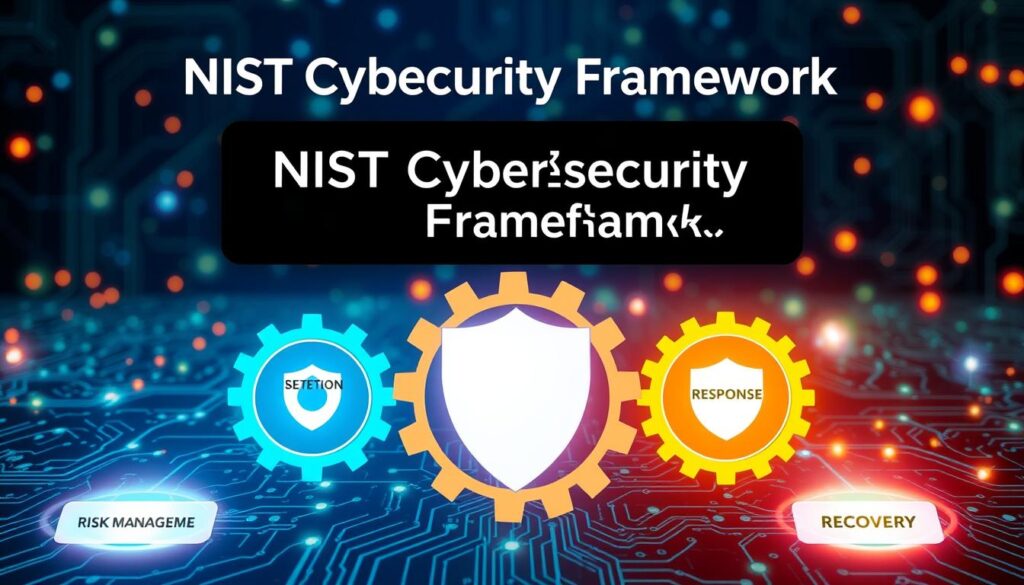
This work is a team effort from industry, academia, and government. It shows that the framework works for all kinds of organizations. With NIST’s tools and resources, businesses can improve their cybersecurity and stay safe from threats.
| Core Functions | Description |
|---|---|
| Identify | Develop an organizational understanding to manage cybersecurity risk. |
| Protect | Implement safeguards to ensure delivery of critical services. |
| Detect | Develop and implement appropriate activities to identify the occurrence of a cybersecurity event. |
| Respond | Take action regarding a detected cybersecurity incident. |
| Recover | Implement activities to maintain plans for resilience and to restore any capabilities or services impaired by a cybersecurity incident. |
Information Security Governance Roles and Responsibilities
In the world of information security, knowing the different roles is key. Each role helps keep your organization safe from threats. This part talks about the CISO duties, the Information Security Manager’s roles, and what security analysts do. It shows how they all help keep your security strong.
Chief Information Security Officer Duties
The Chief Information Security Officer (CISO) is very important. They help make the security rules for the company. The CISO’s job includes:
- Leading security efforts across the company.
- Watching over information assets and making sure they follow the rules.
- Creating security plans that match the company’s goals.
- Working with other leaders to make everyone more aware of security.
- Finding and fixing weak spots in systems and processes.
Roles of the Information Security Manager
The Information Security Manager is in charge of putting security plans into action. Their job is to:
- Handle security problems that come up.
- Make and enforce security rules and standards.
- Manage the security team and make sure everyone knows security is important.
- Check if the company is following security laws.
- Teach employees about security through training.
Key Tasks of Security Administrators and Analysts
Security analysts and administrators deal with the day-to-day security work. Their main tasks are:
- Watching for security problems or strange activities.
- Looking into security issues and making reports for the team.
- Setting up security measures and checking if they work.
- Helping users follow the security rules.
- Helping find and fix security weaknesses.
These roles work together to keep information safe and follow the rules. This helps protect sensitive information and keeps the company in line with laws.
| Role | Main Responsibilities | Key Impact |
|---|---|---|
| CISO | Leads security initiatives, oversees compliance | Protects information assets, reduces risk |
| Information Security Manager | Manages incident responses, develops policies | Enhances security posture, fosters compliance culture |
| Security Analysts | Monitors systems, analyzes incidents | Identifies vulnerabilities, supports operational integrity |
Managing Security Breaches and Risks
Managing security breaches is a big challenge in the world of information security. It involves incident response and learning from past incidents. A good plan is needed to spot threats, stop them fast, and use lessons from past breaches. This helps fix problems now and makes your organization stronger against future attacks.
Incident Identification and Response
Good incident response starts with finding risks and weak spots in your organization. Having strong monitoring systems is key for catching problems early. This helps stop issues fast and keeps damage low. Knowing about threats, what’s valuable, and how to protect it is very important.
- Threat landscape: Knowing about new threats helps you get ready for them.
- Asset valuation: Knowing what’s valuable helps you focus on the most important issues.
- Security controls: Using the right security measures can lower risks a lot.
Think of risk like this: Risk = (threat x vulnerability (exploit likelihood x exploit impact) x asset value) – security controls. This helps you understand risks better and make your response plans smarter.
Learning from Past Security Incidents
Every security incident teaches us something. Doing deep analyses after incidents shows us what went wrong and how to do better next time. To keep getting better, you should:
- Make learning from incidents a part of your culture to avoid the same mistakes.
- Do regular checks to find weak spots and fix them before they’re a problem.
- Use feedback to make your incident response plans better based on what really happens.
By focusing on learning from past incidents, you make your organization stronger and more trustworthy. With a solid plan for managing security breaches, your cybersecurity strategy will be more effective. This helps you stay ready for the fast-changing world of threats.
Conclusion
Information security governance is key for any organization. As cyber threats get more complex, a solid governance framework is vital. It helps manage risks well.
By reviewing governance roles, you can make your operations more efficient and follow rules better. Over 75% of companies say clear roles cut down confusion and boost security follow-through.
It’s important to value the roles of everyone, like business leaders and board members. This teamwork helps build trust and resilience. Companies with strong governance are 30% more likely to handle risks well.
They show how security should be part of all business activities. Keeping governance strategies up-to-date is essential in today’s digital world.
Good governance means clear communication and using the three lines of defense. This reduces risks and improves sharing of information. About 80% of top executives think good governance makes a company ready for anything.
This shows why your company needs strong security and to keep checking its governance practices.
Source Links
- Information Security Governance Roles and Responsibilities
- Governance of Information Security
- What is Information Security Governance ?
- Information Security Governance
- What Is Information Security Governance in Cybersecurity?
- Understanding CISM Domain 1: Information Security Governance
- How Security Governance Can Help Protect You from Cyberthreats
- Council Post: Achieving The Five Levels Of Information Security Governance
- Analyzing role of C-Level executives, management in enhancing cybersecurity within industrial sectors
- GRC Team Roles and Responsibilities: A Brief Guide
- Strategic Cybersecurity: The Essential Role of Boards – The National CIO Review
- The role of Board of Directors in SOC 2 compliance: Necessity or strategic advantage?
- The Board’s Crucial Role in Cybersecurity Governance
- Information Security Governance Framework Guide for IT Activities
- Navigating Cybersecurity Governance: How to Build an Effective Strategy | Secureframe
- Establish Effective Security Governance & Manage…
- How do you integrate security communication with other security processes?
- Making Information Security Project Engagements a Business Process
- Improve Security Governance With a Security Steering…
- Cybersecurity Framework
- Guide: Complete Guide to the NIST Cybersecurity Framework
- Information Security Roles and Responsibilities | Security and Compliance | Michigan Tech
- Information Security Governance, Risk and Compliance team
- Information Security Risk Management (ISRM) | Rapid7
- Information Security Governance – ERMProtect Cybersecurity
- Understanding information security governance
- Roles of Three Lines of Defense for Information Security and Governance
- Information Security Governance vs Information Security Management
- IT Governance Roles and Responsibilities: All You Need to Know
